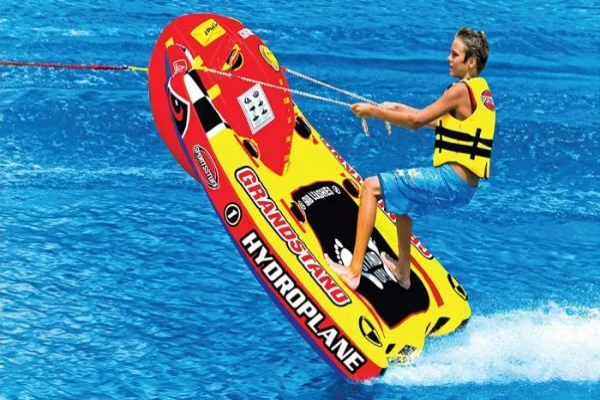Towing a tube behind a jet ski can be an exhilarating and fun-filled activity for people of all ages. Whether you are on a serene lake, a meandering river, or a lively ocean, tubing offers a unique way to enjoy the water. However, to ensure a safe and enjoyable experience, it is crucial to understand the correct techniques and safety protocols. This comprehensive guide will provide you with all the information you need to tow a tube behind a jet ski safely and effectively.
Choosing the Right Equipment
1. Selecting the Right Jet Ski
Jet skis come in various models and sizes. When towing a tube, it is essential to choose a jet ski with adequate power and stability. A jet ski with at least 110 horsepower is recommended. Additionally, ensure that the jet ski has a towing hook or pylon for attaching the tow rope.
2. Picking the Right Tube
Tubes also come in different shapes and sizes. The type of tube you choose should depend on the riders’ age and skill level. Inflatable tubes can accommodate one or more riders. Consider the maximum weight capacity and ensure that it matches the riders’ combined weight.
3. Selecting the Tow Rope
A good tow rope is crucial for a safe tubing experience. The tow rope should be made of durable materials and should be at least 50 feet long. Make sure the rope is designed specifically for water sports and has the necessary strength to withstand the forces exerted during towing.
Safety Precautions
1. Personal Flotation Devices (PFDs)
Every rider on the tube and the jet ski must wear a Coast Guard-approved personal flotation device (PFD). The PFD should fit snugly and comfortably, allowing for free movement without being too loose.
2. Understanding Local Regulations
Before heading out, familiarize yourself with local boating and water sports regulations. Some areas may have specific rules regarding towing speeds, distances from shore, and other safety requirements.
3. Weather Conditions
Always check the weather forecast before going tubing. Avoid going out in rough waters, high winds, or during storms. Calm, clear days are ideal for tubing.
Setting Up the Tow
1. Attaching the Tow Rope
Securely attach the tow rope to the jet ski’s towing hook or pylon. Make sure the connection is firm and that there are no knots or frays in the rope. The other end of the tow rope should be attached to the tube.
2. Checking the Tube
Inspect the tube for any damage or leaks. Inflate the tube to the recommended pressure level. An under-inflated tube can be unstable, while an over-inflated tube might burst under pressure.
3. Positioning the Tube
Place the tube in the water and allow it to float freely. Ensure that the tow rope is not tangled and that it has a clear path to the jet ski.
Communication
1. Hand Signals
Establish a set of hand signals to communicate with the riders. Common signals include thumbs up for faster, thumbs down for slower, and a hand across the throat to stop. Practice these signals before heading out.
2. Two-way Radios
For added safety, consider using waterproof two-way radios. This allows for clear communication between the jet ski driver and the riders, especially if hand signals are not visible.
See Also: How to Bodyboarding with Fins
Starting the Tow
1. Gradual Acceleration
Start the jet ski slowly to avoid jerking the riders off the tube. Gradually increase the speed until the tube is gliding smoothly on the water. Avoid sudden accelerations or sharp turns.
2. Maintaining Speed
Keep a steady speed that is comfortable for the riders. The ideal speed for tubing is between 15 to 25 miles per hour. Adjust the speed based on the riders’ comfort and skill level.
3. Monitoring the Riders
Constantly check on the riders to ensure they are enjoying the ride and are not in distress. Make periodic adjustments to the speed or direction based on their signals.
Navigating the Water
1. Avoiding Obstacles
Keep a lookout for obstacles such as buoys, other boats, and swimmers. Maintain a safe distance from these hazards to prevent accidents.
2. Smooth Turns
Make wide, gentle turns to avoid flipping the tube. Sharp turns can cause the tube to swing out violently, potentially throwing the riders off.
3. Wake Awareness
Be aware of the wake created by your jet ski and other boats. Large wakes can cause the tube to become unstable. Slow down if necessary to navigate through wakes safely.
Ending the Tow
1. Gradual Deceleration
Slow down gradually to bring the tube to a stop. Abrupt stops can cause the riders to be thrown forward. Once the tube is stationary, ensure that the riders are safe before turning off the jet ski.
2. Retrieving the Tow Rope
Carefully reel in the tow rope to avoid tangles. Check the rope for any signs of wear or damage. Store the rope properly to prevent it from getting damaged.
3. Exiting the Water
Assist the riders in exiting the tube and getting back onto the jet ski or onto shore. Ensure that all equipment is collected and stored safely.
Post-Towing Maintenance
1. Inspecting the Equipment
After each use, inspect the tube, tow rope, and jet ski for any damage. Repair or replace any damaged equipment before the next use.
2. Cleaning and Storage
Rinse the tube, tow rope, and jet ski with fresh water to remove salt, sand, and debris. Allow the equipment to dry completely before storing it in a cool, dry place.
3. Regular Maintenance
Perform regular maintenance on your jet ski to ensure it is in good working condition. Follow the manufacturer’s recommendations for servicing and inspections.
Conclusion
Towing a tube behind a jet ski can be a thrilling and enjoyable activity when done correctly. By following the guidelines outlined in this article, you can ensure a safe and fun experience for everyone involved. Always prioritize safety, communicate effectively, and maintain your equipment to enjoy many successful tubing adventures.

